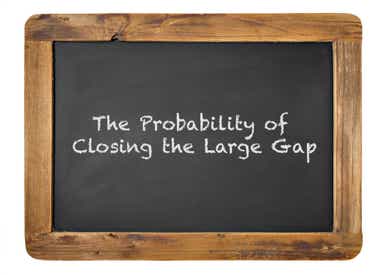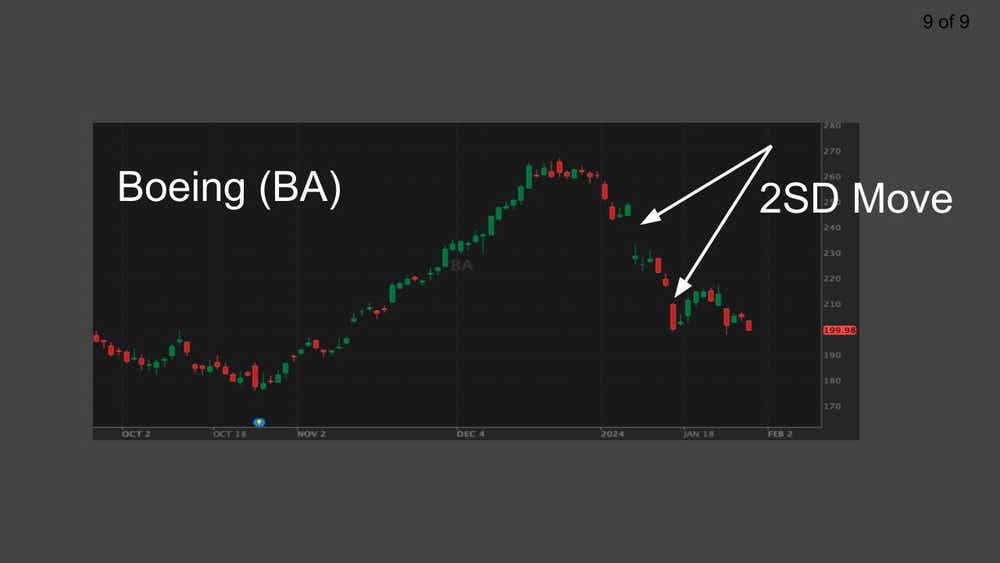The Probability of Closing the Large Gap

The Probability of Closing the Large Gap
By:Kai Zeng
Research unveils the secrets to profiting from stock price reversals
- Two standard deviation moves tend to play out similarly to their theoretical probabilities
- It is rare for gap fills to happen in short time frames, but the odds increase significantly when looking out over 45 days.
- Downside gaps tend to get filled more faster than upside gaps.
Recently, traders often encountered substantial one-sided movements in stock prices, which can occur with or without a catalyst such as an earnings announcement. These large movements can create what's commonly referred to as a "price gap." Understanding the behavior of these gaps is crucial for traders looking to trade the market and select options strategies effectively.

But how quickly and frequently do these gaps close? That is, when do stock prices return to their levels before these dramatic moves? To shed light on this, an analysis was conducted focusing on 20 frequently traded companies in the S&P 500 over the last five years. This study targeted instances where stock prices moved by ±2 standard deviations (SD) from the previous day's closing price—a substantial deviation, as statistical norms suggest about 95% of data points should fall within two SDs of the mean.
One might wonder about the odds of a stock's price recovering after such significant shifts. In a true random market, these ±2 SD moves should theoretically occur around 5% of the time. Our findings align with this expectation, showing gaps get filled within a day about 5% of the time, echoing the theoretical probability. Interestingly, the analysis indicated a slightly higher probability of filling the gap when the initial move was downward.
.jpg?format=pjpg&auto=webp&quality=50&width=1000&disable=upscale)
However, the probability of these gaps being filled changes with time. When extending the observation period to five days and 45 days, the likelihood of the market correcting itself and the price returning to its pre-gap level increased significantly. In fact, in more than half of the observed cases, the stocks' prices reverted to their original levels within a 45-day period.
.jpg?format=pjpg&auto=webp&quality=50&width=1000&disable=upscale)
This insight is particularly valuable for options premium sellers who use neutral strategies like strangles or iron condors. Those who take contrarian positions, choosing longer expiration cycles, such as 45 days, can use that information to enhance the chances of a profitable outcome. The increased time horizon allows for greater flexibility and a higher probability for the market to revert to its mean, thereby potentially benefiting their positions.
To summarize, the analysis reveals two key takeaways for traders. First, the occurrence of large price gaps, such as those involving moves of ±2 SD, tends to align with theoretical probabilities and seems to be independent of external factors. Second, extending the duration of trading strategies can significantly increase the likelihood of profitability, especially for investors employing neutral options strategies or taking contrarian stances.
Kai Zeng, director of the research team and head of Chinese content at tastylive, has 20 years of experience in markets and derivatives trading. He cohosts several live shows, including From Theory to Practice and Building Blocks. @kai_zeng1
For live daily programming, market news and commentary, visit tastylive or the YouTube channels tastylive (for options traders), and tastyliveTrending for stocks, futures, forex & macro.
Trade with a better broker, open a tastytrade account today. tastylive, Inc. and tastytrade, Inc. are separate but affiliated companies.
Options involve risk and are not suitable for all investors. Please read Characteristics and Risks of Standardized Options before deciding to invest in options.